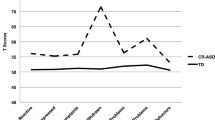Abstract
Behavior checklists are often utilized to screen for Autism Spectrum Disorders (ASDs) when comprehensive evaluations are unfeasible. The usefulness of two behavioral checklists, the Gilliam Autism Rating Scale (GARS) and Child Behavior Checklist (CBCL), in identifying ASDs was investigated among 109 children with Autism, 32 children with ASD, and 51 Non-Spectrum children based on Autism Diagnostic Observation Schedule-Generic classifications. The GARS did not distinguish children with ASDs from those without. The Withdrawn and Pervasive Developmental Problems subscales of the CBCL were higher among children with Autism than among Non-Spectrum children. These CBCL subscales also had better sensitivity and specificity in identifying children with Autism than the GARS. Results suggest that the CBCL is a useful behavioral checklist for screening ASDs.
Similar content being viewed by others
References
Achenbach, T., & Rescorla, L. (2000). Child behavior checklist. Burlington, VT: ASEBA.
American Psychiatric Association. (1994). Diagnostic and Statistical Manual of Mental Disorders (4th ed.). Washington, DC: American Psychiatric Association Press.
American Psychiatric Association. (2000). Diagnostic and statistical manual of mental disorders, 4th edition, text revision, DSM-IV-TR. Washington, DC: APA.
Daugherty, T. K. & Shapiro, S. E. (1994). Behavior checklists and rating forms. In: H. Thomas, N. J. King, & W. Yule (Eds.), International handbook of phobic and anxiety disorders in children and adolescents (pp. 331–347). New York, NY: Plenum Press.
Duarte, C. S., Bordin, I. A. S., de Oliveria, A., & Bird, H. (2003). The CBCL and the identification of children with autism and related conditions in Brazil: Pilot findings. Journal of Autism and Developmental Disorders, 33(6), 703–707.
Edelson, M. E. (2006). Are the majority of children with autism mentally retarded? A systematic evaluation of the data. Focus on Autism and Other Developmental Disabilities, 21, 66–68.
Gilliam J. E. (1995). Gilliam autism rating scale. TX: Pro-ed.
Gilliam J. E. (2006). Gilliam autism rating scale (2nd ed.). TX: Pro-ed.
Kelly, P. A., O’Malley, K. J., Kallen, M. A., & Ford, M. E. (2005). Integrating validity theory with use of measurement instruments in clinical settings. Health Services Research, 40(5), 1605–1619 Part II.
Krug, D. A., Arick, J., & Almond, P. (1993). The autism screening instrument for educational planning, 2nd edition, ASIEP-2. Austin, TX: Pro-Ed.
Lecavalier, L. (2005). An evaluation of the Gilliam autism rating scale. Journal of autism and developmental disorders, online first. Retrieved from http://www.springerlink.com Accessed on 10 November 2005.
Lord, C., Risi, S., Lambrecht, L., Cook, E. H., Leventhal, B. L., DiLavore, P. C., Pickles, A., & Rutter, M. (2000) The autism diagnostic observation schedule-generic: A standard measure of social and communication deficits associated with the spectrum of autism. Journal of Autism and Developmental Disorders, 30(3), 205–223.
Mullen, E. (1995). Mullen scales of early learning: AGS edition. Circle Pines, MN: American Guidance Systems.
Ozonoff, S., Goodlin-Jones, B. L., & Solomon, M. (2005). Evidence-based assessment of autism spectrum disorders in children and adolescents. Journal of Clinical Child and Adolescent Psychology, 34(3), 523–540.
Rutter, M., Le Couteur, A., & Lord, C. (2003). ADI-R: The autism diagnostic interview-revised. Los Angelos, CA: Western Psychological Services.
South, M., Williams, B. J., Mcmahon, W. M., Owley, T., Filipek, P. A., Shernoff, E., Corsello, C., Lainhart, J., Landa, R., & Ozonoff, S. (2002). Utility of the Gilliam autism rating scale in research and clinic populations. Journal of Autism and Developmental Disorders, 32(6), 593–599.
Sparrow, S., Balla, D., & Cicchetti, D. (1984). Vineland adaptive behavior scales—Interview edition. Circle Pines, MN: AGS.
Stone, W. L., Hoffman, E. L., Lewis, S. E., & Ousley, O. Y. (1994). Early recognition of autism. Parental reports vs clinical observation. Archives of Pediatrics & Adolescent Medicine, 148(2), 174–179.
Vig, S. & Jedrysek, E. (1999). Autistic features in young children with significant cognitive impairment: Autism or Mental Retardation? Journal of Autism and Developmental Disorders, 29(3), 235–248.
Acknowledgments
The authors would like to thank the clinicians who comprise the CDRC Autism Team for their dedication to children with autism and their families and their participation in data collection for this study.
Author information
Authors and Affiliations
Corresponding author
Rights and permissions
About this article
Cite this article
Sikora, D.M., Hall, T.A., Hartley, S.L. et al. Does Parent Report of Behavior Differ Across ADOS-G Classifications: Analysis of Scores from the CBCL and GARS. J Autism Dev Disord 38, 440–448 (2008). https://doi.org/10.1007/s10803-007-0407-z
Received:
Accepted:
Published:
Issue Date:
DOI: https://doi.org/10.1007/s10803-007-0407-z



